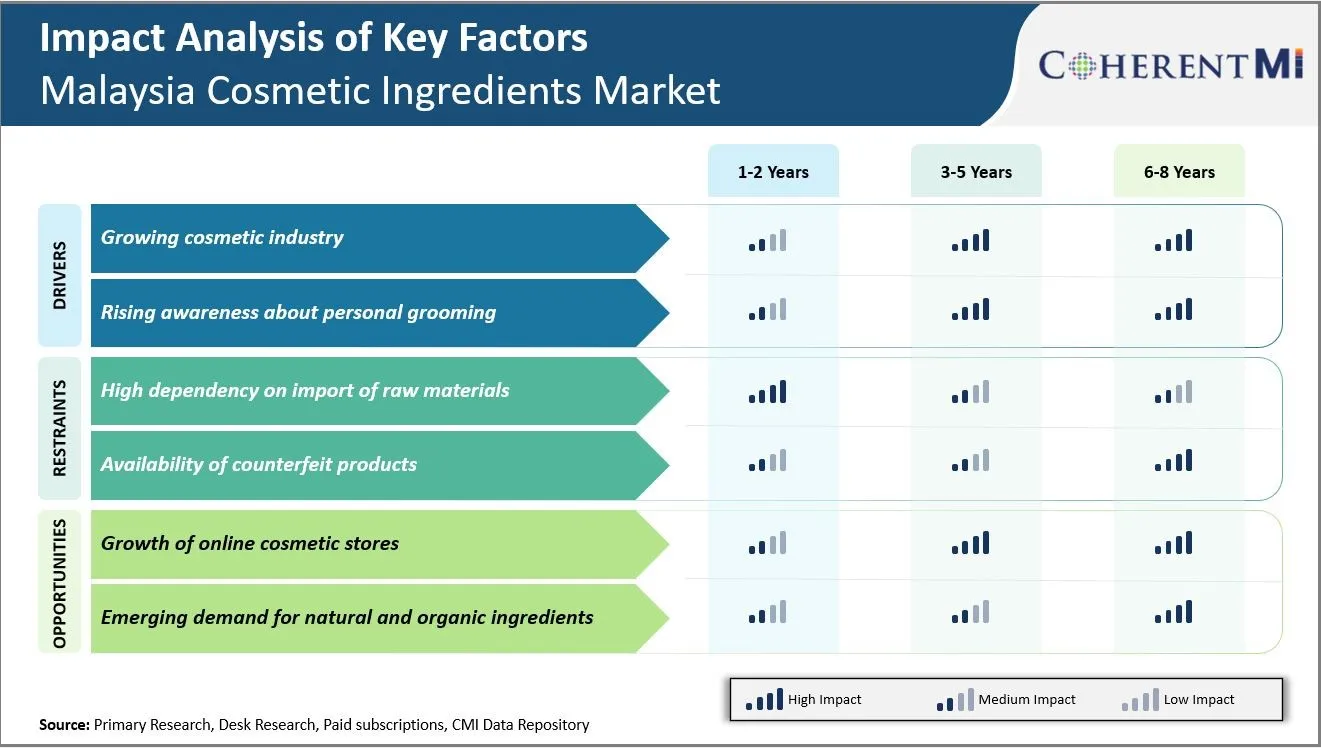Malaysia Cosmetic Ingredients Market Trends
Market Driver - Growing cosmetic industry
The cosmetic industry in Malaysia has been witnessing steady growth over the past decade on the back of rising disposable incomes, increasing urbanization and growing awareness about personal grooming among people. As Malaysia progresses economically, there is a significant rise in middle class population who are willing to spend more on beauty and personal care products. This expanding consumer base has attracted several international cosmetic brands to enter the Malaysia market and launch innovative cosmetic ranges targeting different segments.
Established domestic players have also strengthened their product portfolios and expanded reach through wider distribution networks as well as aggressive marketing campaigns. Major retailers are dedicating greater shelf space to cosmetic categories aiding product visibility. Online cosmetic sales have jumped manifold with growing adoption of e-commerce. Brands are leveraging digital platforms to engage youth and drive trials through interactive content and influencer marketing. Rising penetration of smartphones and availability of low cost data plans have made online shopping more accessible.
Cosmetic production in Malaysia has gained momentum as local manufacturers look to cater to rising local demand as well as explore export potential to other ASEAN countries and China. Cosmetic ingredients form an integral part of the production value chain. To produce quality cosmetic formulations, manufacturers rely on stable supply of crucial ingredients such as oils, vitamins, coloring agents and preservatives meeting all regulatory standards. Local production of certain ingredients has increased on back of supportive regulatory environment and resource availability however Malaysia still imports variety of unique ingredients in smaller volumes not commercially viable to produce locally.
Market Driver - Rising awareness about personal grooming
With rapid urbanization and internet/social media proliferation, traditional beauty standards are evolving in Malaysia. Increased exposure to global pop culture and rising disposable incomes have made Malaysians more conscious about personal appearance and grooming. Beauty blogs and videos are extensively consumed by young Malaysians to remain updated about latest make up and skin care trends. Celebrity endorsements and digital marketing campaigns focused on aesthetic appeal have driven the need to look stylish and feel confident among both men and women.
Malaysians are no more hesitant to spend on variety of personal care products from skin lightening creams to anti-ageing serums to achieve the desired look. Masstige cosmetic brands catering to prestige minded consumers demanding high performance yet affordable products have grown popularity. Specialized cosmetic stores as well as boutique salons/spas concentrated on personal grooming services have proliferated in major cities of Malaysia capitalizing on this increased self-image awareness.
Regular use of cosmetic products, whether for basic makeup or advanced skin treatments requires active participation from Malaysia men as well who are also gradually shedding inhibitions around personal care routines. As looking good and feeling confident about appearance gains significance, it has contributed to the demand for cosmetic ingredients that deliver results in safe, natural yet effective manner and cater to evolving beauty expectations of today's generation.

Market Challenge: High Dependency on Import of Raw Materials
The Malaysia cosmetic ingredients market faces a major challenge in its high dependency on imports for raw materials. According to our research, over 70% of the raw materials used in the domestic cosmetic industry are imported due to lack of local sources and manufacturing. This makes the industry highly vulnerable to fluctuations in global prices and supply chain disruptions. In the past year, rising tariffs due to ongoing trade tensions have increased procurement costs significantly for Malaysian cosmetic companies. Supply chain delays during the COVID-19 pandemic further impacted inventory levels and production schedules. With limited control over international raw material prices and supplies, the industry has difficulties planning budgets and ensuring consistent product availability. This potentially erodes customer confidence and trust in Malaysian cosmetic brands. To address this issue and develop a sustainable local supply chain, concerted efforts are required to cultivate homegrown sources for key raw materials through industry-academia tie-ups and incentives for local manufacturers.
Market Opportunity: Growth of Online Cosmetic Stores
The booming online retail market in Malaysia presents a major opportunity for the domestic cosmetic ingredients industry to tap into. E-commerce has grown at a phenomenal pace in recent years driven by rising internet and smartphone penetration as well as changing consumer habits among the urban population. Various reports estimate the size of the Malaysian e-commerce market to cross the USD 10 billion mark by 2025. This rapid growth is translating to a surge in the number of online cosmetic stores as well. Through dedicated websites and platforms like Lazada and Shopee, these digital-firststores are making a wide range of beauty and skincare products available to customers with convenience of online shopping. Local cosmetic ingredient suppliers and manufacturers have a chance to leverage this channel to boost sales volumes and market reach. They can partner with leading online cosmetic retailers and supply products on an exclusive basis. Suppliers can also adopt advanced marketing strategies like targeted digital ads and influencer promotions to raise brand awareness online. Tapping into the growth of online cosmetic shopping thus presents major business opportunities for Malaysian cosmetic ingredients companies.